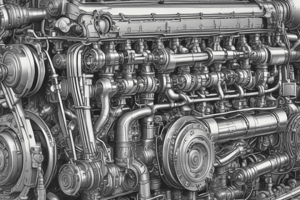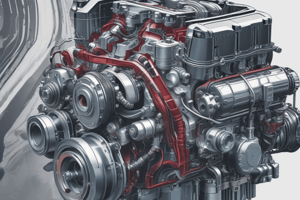Podcast
Questions and Answers
What is the primary function of an engine in a vehicle?
What is the primary function of an engine in a vehicle?
- To provide the rotating power to drive the wheels through the transmission and driving axles (correct)
- To generate electricity for the vehicle's electrical systems
- To provide compressed air for the vehicle's air suspension system
- To cool the vehicle's cooling system
What is the combustion chamber in an engine?
What is the combustion chamber in an engine?
- The location where the engine's valves are operated
- The space between the piston at the top of its travel and the cylinder head (correct)
- The space between the piston at the bottom of its travel and the cylinder block
- The area where the engine oil is stored
What is the ideal condition for complete combustion in an engine?
What is the ideal condition for complete combustion in an engine?
- When all the fuel in the chamber is burned, but not all the air
- When all the air in the chamber is burned, but not all the fuel
- When the right amount of fuel is mixed with the right amount of air, and the mixture is compressed in a sealed container and ignited by the right amount of heat at the right time (correct)
- When the fuel and air are mixed in any proportion and ignited at random
What percentage of the released energy is converted to useful power in an engine?
What percentage of the released energy is converted to useful power in an engine?
Why do automotive engines have more than one cylinder?
Why do automotive engines have more than one cylinder?
What is the purpose of valves in an engine?
What is the purpose of valves in an engine?
What happens when a valve is said to be seated or closed?
What happens when a valve is said to be seated or closed?
What happens when a valve is pushed off its seat?
What happens when a valve is pushed off its seat?
Flashcards
Combustion Chamber
Combustion Chamber
The space inside an engine cylinder where the air-fuel mixture is burned.
Complete Combustion
Complete Combustion
A process where nearly all the fuel is burned in the cylinder, requiring the right mixture of fuel and air, compression, and ignition at the right time.
Engine Efficiency
Engine Efficiency
The ratio of energy converted into useful power to the total energy released.
Valve
Valve
Signup and view all the flashcards
Camshaft
Camshaft
Signup and view all the flashcards
Cam Lobes
Cam Lobes
Signup and view all the flashcards
Valve Seated
Valve Seated
Signup and view all the flashcards
Valve Open
Valve Open
Signup and view all the flashcards
Study Notes
Engine Fundamentals
- An engine provides rotating power to drive the wheels through the transmission and driving axles.
Internal Combustion Engines
- Classified as internal combustion because the combustion or burning of fuel takes place inside the engine.
- Engines, both gasoline and diesel, require construction to withstand high temperatures and pressures created by burning vaporized fuel mixed with air.
Combustion Chamber
- The space between the piston at the top of its travel and the cylinder head.
- An enclosed area where the air/fuel mixture is burned.
Complete Combustion
- Requires the right amount of fuel mixed with the right amount of air.
- Mixture must be compressed in a sealed container, then ignited by the right amount of heat at the right time.
- Nearly all fuel that enters a cylinder is burned when these conditions exist.
Engine Efficiency
- About 30 percent of released energy is converted to useful power that moves the vehicle.
- Automotive engines have more than one cylinder to increase power.
Cylinder Requirements
- Each cylinder should receive the same amount of air, fuel, and heat for efficient engine operation.
- Cylinders require a way to allow heat, fuel, and air in and burnt air/fuel mixture out.
Valves
- Fitted to engines to meet cylinder requirements.
- At least two valves at the top of each cylinder: intake valve and exhaust valve.
- Valves are accurately machined plugs that fit into machined openings.
- Valve is said to be seated or closed when it rests in its opening or seat.
- Valve opens when pushed off its seat.
Camshaft Operation
- Rotating camshaft, driven by the crankshaft, opens and closes intake and exhaust valves.
- Cams are raised sections of a shaft with high spots called lobes.
- Cam lobes are oval shaped.
- Lobe placement on the shaft determines when the valve will open.
- Height and shape of the lobe determines how far the valve will open and how long it will remain open in relation to piston movement.
Studying That Suits You
Use AI to generate personalized quizzes and flashcards to suit your learning preferences.





